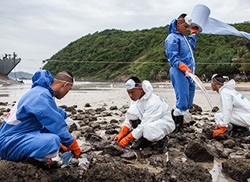Shoreline

Wetlands
Wetlands, which include upland and inland marshes, swamps, and bogs, are highly sensitive to spills; they collect run-off from their surrounding environments and are home to many vital species, both commercially and ecologically.
Similar to the way booms are used on water, berms can be used to contain or divert spills for recovery through skimmers and vacuums. Other appropriate response techniques include sorbents and in-situ burning, along with bioremediation. The use of heavy equipment in wetlands is often not practical because of the associated potential environmental damage.
Rocky Cliffs and Beaches
Exposed rocky shores are typically less sensitive to oil spills, with the exception of when wildlife habitats or breeding grounds are present. Because the rocks generally do not absorb much oil, the spilled material is held mostly offshore, and any oil that is deposited remains on the rock surface where it is subject to biodegradation.
If response activities occur, they will take the form of manual cleanup efforts – flushing, debris removal, vacuuming, etc. Bioremediation is another potentially effective option, using agents such as fertilizers to speed the degradation process. In remote areas, in-situ burning may be considered, while sorbents may be used as a final "polish" after other response options have been used.
Sand and Gravel Beaches
Perhaps the greatest threats posed by spills on a sandy or gravel beach are to recreation and commerce. The beaches are only moderately sensitive to spill damage, as plant life is minimal and most resident organisms are deep burrowers. However, some beaches are host to sea turtle eggs, and back beach areas can be important nesting grounds for birds.
Earth-moving equipment can effectively remove soiled sediments from sandy beaches. Gravel beaches tend to be more loosely packed, and heavy equipment can grind oil further into the underlying earth. When large amounts of sediment must be removed, it may be necessary to replace them with clean materials.
Other potentially effective cleanup techniques include flushing, vacuums, sorbents, and solidifiers. In rare cases, in-situ burning may be appropriate.
Coastal Waters
Response to spills closer to shore (in water depths less than approximately 30 feet) must take into account both the potential of the spill to reach shore and its potential impact on corals, kelp and seagrass beds, and their dependent ecosystems.
Booms may be used to divert or contain oil for recovery via skimmers or burned off. Dispersant use is discouraged due to the potential for dispersed oil to affect shallow coastal ecosystems. However, they may be applied in coastal waters without significant subsurface habitats.
Sorbents may be used for small-volume spills, or as a final "polish" after other response options have been used.
Mudflats, Mangroves, and Salt Marshes
Mudflats, mangroves, and salt marshes are examples of highly sensitive habitats – both to spills and to cleanup activities. Coastal marshes and mangrove forests are among the most productive ecosystems in the world, providing habitats and breeding grounds for many vital species. Generally, it is not feasible to move response equipment into and out of these environments without causing excessive damage. Even foot traffic must be minimized, either by laying down wooden walkways or relying on boat-based activities as much as possible.
Effective response techniques may include bioremediation and the use of vacuums and sorbents. Berms can be used to contain or divert contaminated water, but must be constructed and removed with care. In rare cases, dispersants may be used at the edge of mangrove forests if it is determined that non-dispersal poses too great a risk to the ecosystem. Similarly, in-situ burning is a less preferred, but occasionally appropriate response option in salt marshes.
Shorelines and Marinas
In open-water marine spills, the primary response objectives are:
- To prevent the spill from reaching shore,
- To reduce the impact on marine life, and
- To speed the degradation of any unrecovered oil.
In the absence of significant native plant or animal life in these environments, economic and aesthetic factors generally drive spill response decisions. Removal is typically a top priority, as these developments are often constructed in areas where wave activity, and therefore natural dispersion, is minimal.
Booms and skimmers are used to contain and remove spilled oil from the water, while relatively aggressive cleanup activities are used to address oil that has reached shore. These activities may include flushing, use of shoreline cleaning agents, and bioremediation. Sorbents also may be used for smaller-volume spills, or as a final "polish" after other response options have been used.

